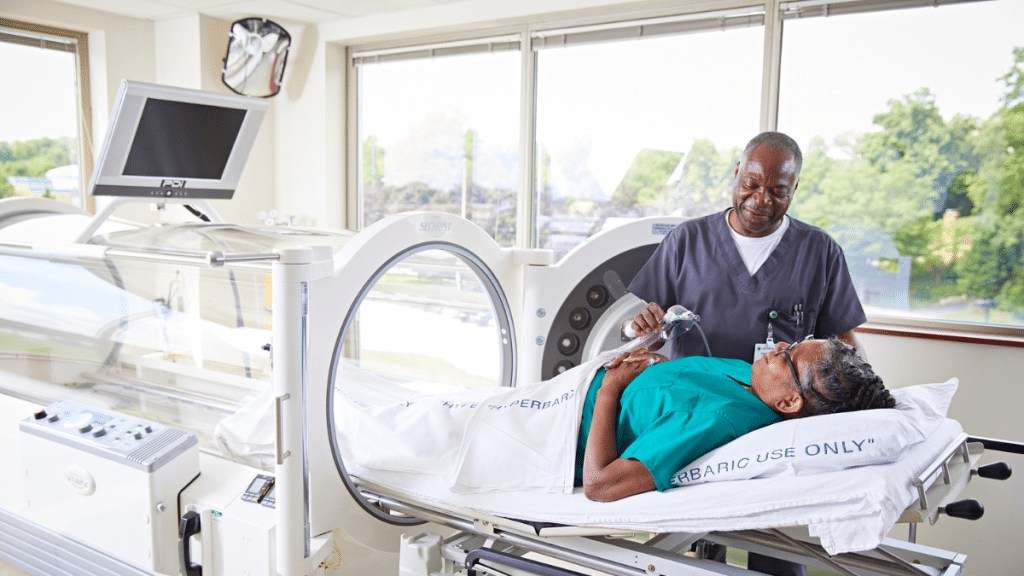Healing after surgery or illness often hinges on the choices people make. Every action—from medical decisions to daily routines—can influence how recovery unfolds. Staying actively involved in the process tends to lead to fewer setbacks and better long-term outcomes.
Doctors often point to a handful of simple, science-backed strategies that make a real difference. These include starting hyperbaric therapy early, following a personalized anti-inflammatory diet, building strong sleep habits, tracking mobility daily, and practicing lymphatic care. Each step gives patients more control and helps support a faster, steadier recovery.
Starting Hyperbaric Therapy Early in Recovery
Mild hyperbaric oxygen therapy, started within the first few days after surgery, can speed healing by delivering extra oxygen to areas where circulation is limited. Many doctors recommend beginning treatment within 48 to 72 hours, when it’s most effective at reducing swelling and discoloration around joints or surgical sites. Patients often describe improved energy and clearer thinking, likely from increased oxygen reaching the brain.
Targeting specific surgical areas with hyperbaric therapy sessions often leads to greater comfort and faster recovery. Talk with your doctor before surgery to see if this approach aligns with your overall plan, especially if you’re expecting joint swelling or limited circulation post-op.
Creating a Personalized Anti-Inflammatory Diet Before Leaving the Hospital
A diet focused on reducing inflammation can support healing and overall well-being. Collagen-rich foods like wild-caught salmon and bone broth aid tissue repair, which is especially important after surgery. A balanced approach to eating can also prevent digestive issues that may delay recovery. Staying mindful of hidden food triggers—sometimes found in items labeled as healthy—can make a big difference in how your body responds during the healing process.
Starting with low-FODMAP foods supports the gut, while slowly adding fiber helps ease back into regular eating. This slow, thoughtful process helps the body heal without added stress. Keeping a simple food journal to track what you eat and how you feel can highlight problem foods and help improve your meals.
Practicing Good Sleep Habits From the Start
Quality sleep is a key factor in recovery. Exposure to morning sunlight helps reset the internal clock, which may be disrupted by medications or stress. A small shift in light exposure can support mood, hormone regulation, and natural sleep patterns. In the evening, magnesium supplements may encourage deeper, more restful sleep.
Cutting back on caffeine and limiting screen time before bed creates a calmer nighttime environment. Simple adjustments like these can ease physical tension and quiet mental restlessness. A consistent bedtime routine—such as light stretching, journaling, or reading—signals the body to wind down and supports feeling more rested by morning.
Keeping Track of Progress With a Daily Mobility Log
Writing down daily recovery experiences in a mobility log can support healing and help reveal patterns. Tracking pain, movement, and energy levels makes it easier to understand how the body responds over time. Noticing small wins—like reaching farther or walking more—can increase motivation and create a sense of progress, especially during slower phases of recovery. Thoughtful tracking also strengthens body awareness.
Sharing the log with your healthcare team allows them to adjust care based on your real-time experience. Consistent back-and-forth communication helps keep your recovery plan aligned. Using a phone app or a notebook to make quick daily notes can shift your mindset and make recovery feel more active and engaging.
Making Lymphatic Stimulation Part of Your Daily Routine
Lymphatic stimulation offers valuable support during recovery, especially in reducing swelling and easing discomfort. Simple techniques like dry brushing help move fluid, promote waste removal, and support circulation. Using a soft-bristle brush before showering—brushing gently upward toward the heart—can improve lymph flow with minimal effort. These small, consistent actions bring relief to sore areas and help the body recover more efficiently.
It may also prevent scar tissue from sticking, keeping affected areas more flexible. It also strengthens the immune system, making it easier for the body to fight off infection. Setting aside time each day for dry brushing or light movement can be a valuable part of your recovery.
Healing improves when patients take consistent, thoughtful steps each day. Starting hyperbaric oxygen therapy early, eating to reduce inflammation, and prioritizing restful sleep all build a foundation for progress. Tracking mobility helps highlight small wins and maintain focus, while gentle practices like dry brushing support circulation and ease discomfort. These routines don’t need to be perfect—they simply need to be repeated with care. Each habit adds momentum and fosters a sense of control. Recovery is not just the passage of time; it’s an active process. Talking with your doctor can help you choose steps that match your specific needs.
